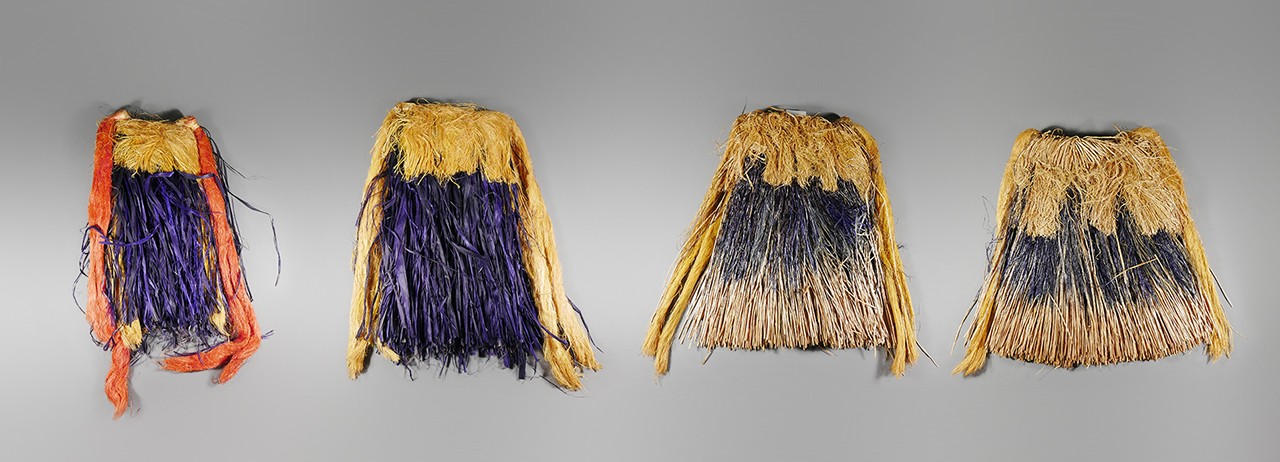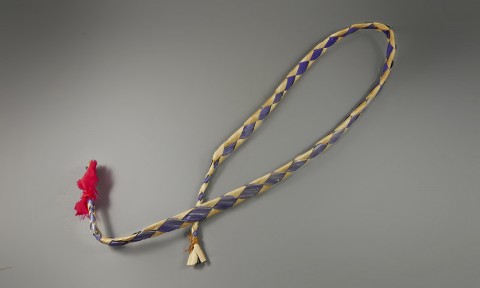 |
Frieda, Ellen and Carolyn performing at the opening of the Bai ra Nagsechel ar Cherchar, 1969
Image courtesy of Frieda Wray |
Beginning of the End
The electric opening of the Palau Museum’s Bai ra Nagsechel ar Cherchar was marked with dancing and music, but there is always more going on than meets the senses. In last week’s post the Bowers Blog explored some of the symbolism of these dances, and how they exist as part of the Palauan oral tradition. Today’s final post in our series on the Osborne family ties up the family’s second extended trip to Palau and returns to the Blog’s usual role of exploring the material objects the opening of the bai produced. Below we look at the outfits worn by the Osborne family at the opening, primarily composed of bandeaus, grass skirts and other adornments, and finally end the series with a historical note about the bai.
 |
Bandeau, mid 20th Century
Ngerbeched Hamlet, Koror Island, Palau, Micronesia
Cotton and elastic; 6 × 12 × 1 1/2 in.
2019.17.14
Gift of Frieda O. Wray from the Estate of Dr. & Mrs. Douglas and Carolyn Osborne |
Addressing the History
The first written accounts of Palau date to the 16th Century and describe the traditional women’s attire from the waist up to have been limited to bead or shell necklaces. Topless presentation was the norm due in part to the lack of necessity for clothing presented by the climate. Despite this, western influence steadily pressured Palauan women to wear tops as an act of modesty. Early coverings were made from raw materials sourced from the islands: coconut shells, woven pandanus leaves and even turtle shells, but by the middle of the 20th Century the indigo bandeaus worn by one of the Osborne family during the dances at the bai opening were already considered traditional. Given that the indigo used in the band was non-locally sourced it is a possibility that the garment did not originate from Palau.
 |
Hip Skirts (Gerévut), mid 20th Century
Ngerbeched Hamlet, Koror Island, Palau, Micronesia
Raffia and hibiscus fiber
2019.17.10-.13
Gift of Frieda O. Wray from the Estate of Dr. & Mrs. Douglas and Carolyn Osborne |
Hip Check
The next component to the Palauan dance costume is the gerévut—the Palauan grass skirt. The gerévut consists of two skirt pieces: the madál or front piece, and the dél or back piece. It is customary for the women of Palau to handcraft their grass skirts using various plants materials sourced from the island such as taro grass, hibiscus fiber, or raffia palm. The process of constructing just one of the skirt pieces begins with softening the plants in sea water and then utilizing a mother-of-pearl shell to scrape and remove the epidermis—the slimy residue of the plant. Once sun dried, the plant materials are then split into wide strips by hand and dyed with natural pigments like red clay, turmeric powder, soot, or mud from the taro swamps. The indigo pigment used in all four skirt pieces in the collection came from carbon paper provided by Dr. Osborne, a surprisingly prevalent practice at the time. The madál and dél are assembled by weaving together the plant strands and securing them with a braided band. Palauan women often make multiple types of gerévut—as each are intended for different purposes or ceremonies. The grass skirts featured in the collection were made by the local women’s club.
|
|
Hip Cord (Tăgúl or Tăgĕlél), mid 20th Century
Ngerbeched Hamlet, Koror Island, Palau, Micronesia
Turtle shell and fiber; 3/4 × 45 in.
2019.17.9
Gift of Frieda O. Wray from the Estate of Dr. & Mrs. Douglas and Carolyn Osborne |
Belt (Ptek or Ptekél), mid 20th Century
Ngerbeched Hamlet, Koror Island, Palau, Micronesia
Fiber and cloth; 3/4 × 45 1/2 in.
2019.17.8
Gift of Frieda O. Wray from the Estate of Dr. & Mrs. Douglas and Carolyn Osborne |
Belt and Hip-Cord
The ensembles worn by the Osborne family for the dances also included two important accessories: the ptekél and the tăgúl—the belt and the hip cord respectively. These are primarily worn to secure the gerévut. The ptekél is commonly made by weaving together plant fibers in a diamond pattern. According to one researcher, Palauan women prefer to wear the ptekél tightly around their flanks for the purpose of supporting the skirts and their stomachs. The tăgúl is traditionally black in color and made with dugong skin, slices of coconut shell or turtle shell. Unlike the ptekél, the tăgúl is tied by the wearer around their sides for the purpose of supporting the many pieces of the grass skirt. During the opening ceremony of the Bai ra Ngesechel ar Cherchar each of the Osborne sisters wore matching ptekél and tăgúl.
|
|
| Frieda and Ellen Osborne in the ensembles they wore the day of the bai opening, 1969
Image courtesy of Frieda Wray
|
Up in Smoke
Following the ceremonial proceedings, the bai formally opened for the public. As part of the Palau Museum, the bai served as a center for promoting community involvement and educational programs for the next several years and the Osborne family’s documentation of the construction was featured in the museum’s opening dedication brochure. Not long after the opening of the bai, the Osborne family concluded their 1969 research trip to Palau. Though Dr. Douglas and Carolyn Osborne visited the islands many more times throughout their lives this was the last time they lived in Palau for an extended stay. Having dedicated so much time to the building’s opening, the real tragedy is that the building did not last long. In October of 1979, faulty wiring for the building’s electric lighting sparked, causing the bai to burn to ashes. Ironically the electricity was likely installed in part to reduce the risk of a fire by reducing the need to light bonfires in the pits. It has been to date the last known bai to have been built using traditional Palauan carpentry. But the dream did not burn. In March of 1991, a new bai was built using modern methods in the same location with the collaboration of the Republic of Palau's 3rd National Congress and the Palau Visitors Authority. It still stands to this date, filling the same role as the structure the Osborne family assisted with.
Post researched and co-written by Jessica Arellano, Volunteer for the Bowers Museum Collections Department. Text and images may be under copyright. Please contact Collection Department for permission to use. References are available on request. Information subject to change upon further research.









Comments